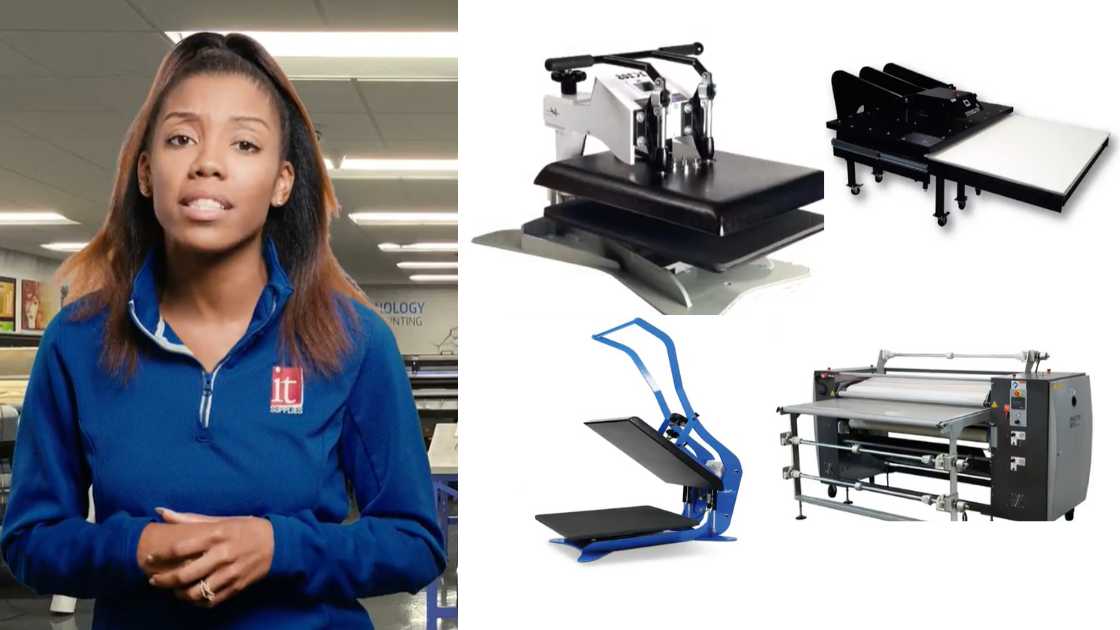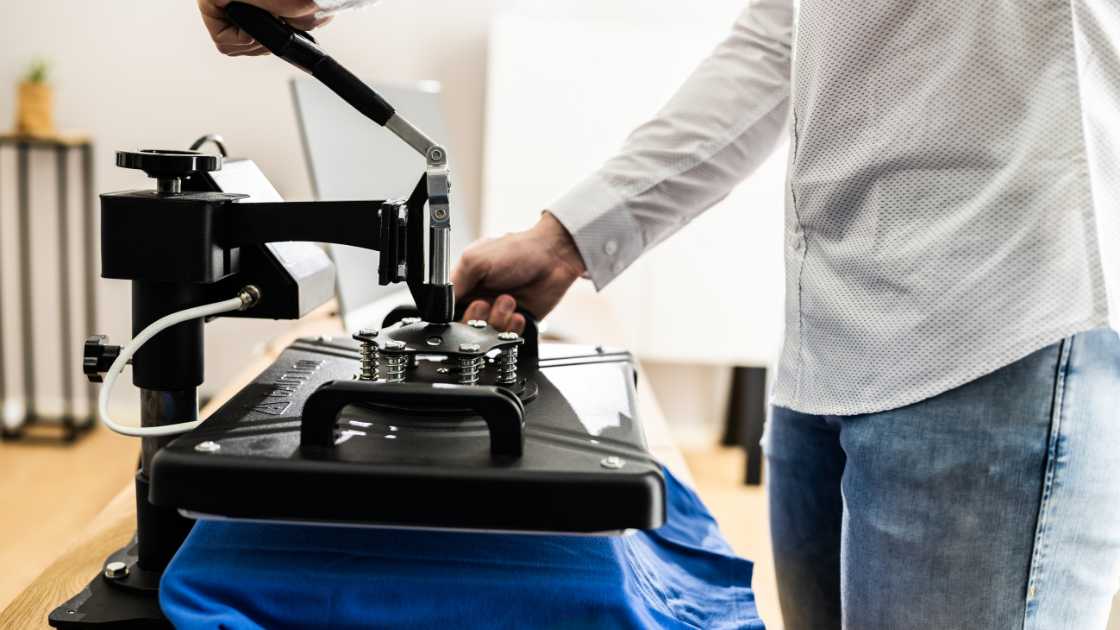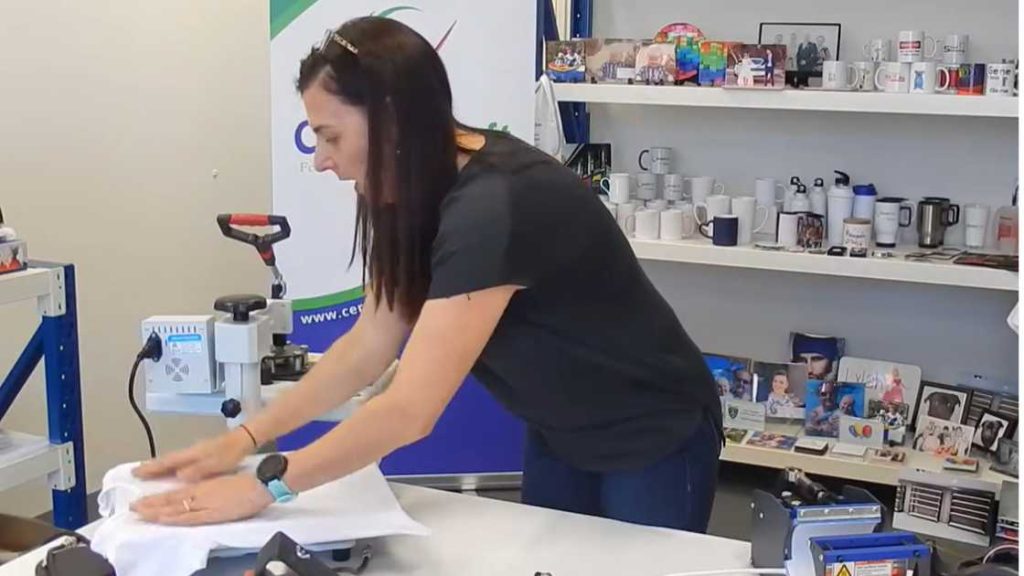A heat press can turn a white shirt yellow due to high temperature or prolonged exposure. Adjusting temperature and time settings can remedy this issue.
Using a heat press for custom designs on t-shirts is a popular method, but it can sometimes lead to unexpected results such as yellowing on white shirts.
This typically happens when the heat press temperature is set too high or the shirt is left under the heat for too long.
Yellowing can also occur when a protective sheet isn’t used, or if the heat press hasn’t been properly cleaned and residual dyes transfer to the shirt.
By the machine’s settings and the fabric’s heat sensitivity, you can prevent discoloration.
Before you start, check the manual and clothes tag to set the right heat and time for keeping whites bright. Avoid yellow tints.
Now let’s Explain “Why Heat Press Turned White Shirt Yellow?”

The Heat Press Dilemma: White Shirts Turning Yellow
Imagine watching your spotless white shirt coming out of the heat press with an unwanted yellow tint. It’s a common and frustrating problem for many individuals and businesses working with heat press machines.
It’s important to identify why this occurs to prevent wasted materials and unsatisfied customers.
Common Reasons For Discoloration
Various factors can cause a white shirt to turn yellow during the heat-pressing process. Let’s Investigate some of the common culprits:
- High Temperature: Exceeding the recommended heat levels for specific fabrics.
- Long Press Time: Keeping the shirt under the press for too long can result in burns.
- Dye Migration: Dyes from polyester fabrics can bleed when exposed to heat.
- Scorching: Natural fibers like cotton are prone to scorching at high temperatures.
- Chemical Reactions: Residual chemicals on the shirt react with heat.
The Science Behind The Yellowing Effect
The science helps in preventing yellowing:
| Reason | Scientific Explanation |
|---|---|
| Heat Exposure | High temperatures cause oxidation and can break down fibers. |
| Chemical Reaction | Laundry detergents or fabric softeners may contain substances that change color with heat. |
| Moisture Content | Excess moisture can lead to steam, which may result in yellow stains or marks. |
| Dye Migration | Sublimation inks or fabric dyes can sublimate at high temperatures, tinting white areas. |
Being aware of these issues is the first step to keeping your white shirts bright and vibrant after heat pressing.
Choosing The Right Heat Press Settings

Choosing the right heat press settings is vital for ensuring your white shirt doesn’t turn yellow. This unfortunate mistake can spoil your project.
To prevent discoloration, you must use specific settings. These depend on the type of fabric being pressed.
Ensuring you have the correct temperature and timing is key. Let’s Investigate how to set these controls accurately.
Temperature Control For Different Fabrics
Different fabrics need different heat levels. Here’s a quick guide:
- Cotton: Set between 380°F and 410°F
- Polyester: Lower temperatures, around 270°F to 300°F
- Spandex and lycra: Similar to polyester, stay under 300°F
Remember, using too much heat can cause yellowing. Always test on a scrap fabric piece first.
Timing Precision To Avoid Scorching
Not only does temperature matter, but timing too. Here are steps to avoid burning your fabric:
- Check the heat press manufacturer’s recommendations.
- Use a stopwatch for accuracy.
- Press no longer than necessary. Usually, 10-20 seconds.
- For thinner fabrics, use less time. For thicker, use more time.
- Immediately remove the shirt after pressing.
Right timing prevents yellow stains and maintains shirt quality.
Pre-press Preparations To Prevent Yellowing
The excitement of creating custom apparel can quickly fade when a fresh white shirt turns yellow under a heat press. Adequate pre-press preparations can safeguard against this outcome.
This section of the blog post delves into essential steps to prevent yellowing during the heat-pressing process.
Pre-press Garment Care Tips
Proper garment handling is key. Starting with a clean, lint-free shirt ensures no impurities contribute to yellowing. Always pre-wash fabrics without fabric softeners, as these can cause discoloration under heat.
A quick press before the actual application removes moisture and wrinkles, leading to a clean pressing environment.
- Inspect the shirt for stains or marks.
- Pre-wash the garment to remove residues.
- Lay the shirt flat to even out any folds.
- Preheat the shirt gently to eliminate moisture.
Importance Of A Clean Heat Press
A clean plate is as important as the garment’s condition. Residual dyes, inks, or adhesives from previous uses can transfer to a white shirt and cause yellowing.
Regular cleaning of the heat press maintains a spotless surface. Use a non-abrasive cleaner after each use to keep the press pristine.
| Maintenance Task | Frequency |
|---|---|
| Wipe down the heat plate | After every use |
| Check silicone pad | Weekly |
| Inspect for residue buildup | Monthly |
Material Matters: Selecting Shirts For Heat Press
Ever seen a perfect white shirt turn yellow after a heat press? It’s all about the fabric. Pick the right material, and your designs will look fresh and last longer.
Which fabrics to choose can prevent that dreaded yellowing? Let’s probe the best shirt materials for heat pressing and how they can make a world of difference.
Fabrics That Resist Heat Press Yellowing
Certain fabrics stand up to heat better than others. These materials ensure your white shirts remain pristine:
- 100% Cotton: Breathable and heat-friendly.
- Polyester: Less likely to discolor with heat.
- Poly-Cotton Blends: Offers a balance of cotton comfort and polyester resilience.
- Rip-stop Nylon: Durable and heat resistant.
Choosing quality over price pays off when it comes to longevity and appearance.
How Fabric Blend Affects Outcome
The mix of materials in your shirt can determine its fate under a heat press. A good blend minimizes yellowing. Here’s how different combinations fare:
| Fabric Blend | Heat Resistance | Print Quality |
|---|---|---|
| 100% Cotton | Good | Excellent |
| 100% Polyester | Great | Good |
| 50/50 Cotton-Polyester | Best | Very Good |
| Triblend (Cotton-Polyester-Rayon) | Varies | Very Good |
Selecting the optimal fabric blend is essential for a successful heat press application. Quality blends offer durability and better color retention.
Chemical Reactions: Why Things Turn Yellow
Ever pressed a design onto a shirt only to find it turned yellow? You are not alone. Many factors can cause a pristine white shirt to yellow under a heat press. Let’s sink into the chemical reactions at play and how you can prevent discoloration.
Interaction Between Heat, Fabric, And Detergents
Heat-pressing white shirts can sometimes lead to yellowing. Why does this happen? Here’s a look at the key players.
- Heat: High temperatures can scorch fabric, causing a burn-like discoloration.
- Fabric: Synthetic fibers tend to yellow more easily than natural ones under heat.
- Detergents: Some contain bleaching agents that react with heat, changing fabric color.
Combining these elements incorrectly can lead to unwanted yellow tints on your shirt.
Antiperspirants And Their Role In Discoloration
Antiperspirants are not just for keeping you dry. They can also affect your shirts!
| Ingredient | Role in Discoloration |
|---|---|
| Aluminum Compounds | React with sweat and fabric, leaving yellow stains |
| Other Chemicals | May interact with heat, causing color change |
the chemicals in your antiperspirant help you minimize yellowing.
Expert Tips For Yellow-free Heat Press Outcomes
If you’ve ever encountered the frustration of a white shirt turning yellow after a heat press session, fear not – there are expert tips to ensure yellow-free outcomes.
How Do I Increase the Pressure on My Heat Press? One vital factor in preventing heat press marks is adjusting the pressure correctly.
If you’re wondering, “How do I increase the pressure on my heat press?” start by consulting your machine’s manual. Optimal pressure ensures a clean transfer without causing yellowing on fabrics.
How Do You Prevent Heat Press Marks? To avoid those unsightly heat press marks, make sure your heat press is prepped and ready.
Knowing when a heat press is ready is key – wait for the indicator or follow the manufacturer’s guidelines.
Removing Heat Press Marks on Different Fabrics For polyester, use expert tips for yellow-free heat press outcomes, ensuring you don’t end up with shiny iron marks. Jennifer Maker’s sublimation startup guide can be a valuable resource.
If scorch marks do occur, learn how to remove them, whether on polyester or cotton, ensuring your garments come out pristine and mark-free.
Remember, with the right knowledge, you can enjoy the benefits of a heat press without worrying about yellowing or unsightly marks.
For more in-depth insights, check out our expert tips for yellow-free heat press outcomes PDF.
Professionals have secret methods to prevent yellowing. The secrets are simple yet effective:
- Pre-tests on scrap fabric or a small area
- Correct heat settings for different fabrics
- Use of Teflon sheets or parchment paper
- Proper timer settings to avoid overheating
- Immediate removal of items after pressing
Adjusting Pressure For Optimal Results
Appropriate pressure is critical in getting that perfect press. How do you know if it’s right? Ensure your press provides even pressure throughout.
Adjusting your machine beforehand can make a world of difference:
- Read the manual to understand your machine’s pressure settings.
- Perform a pressure test, adjusting as needed before pressing shirts.
- Not too firm – it could mar the fabric. Not too light – the design won’t stick.
- Check the pressure regularly for consistency in quality.
Sustain the quality of your white shirts with these methods. Say goodbye to unintended yellow hues and welcome spotless, professional results!
Anecdotes From Personal Experience
Starting on a creative journey with a heat press can lead to stunning results. Yet, sometimes, even the most experienced craft enthusiasts encounter the dreaded issue of a white shirt turning yellow.
Personal tales of trial and error shine a light on common pitfalls and the pivotal moments that turned failure into success. Let’s dip into real stories from behind the heat press.
Real-life Scenarios Of Success And Failure
Finding success with heat pressing often feels rewarding. Imagine pressing a detailed vinyl design onto a white shirt. You peel off the transfer sheet to reveal a flawless, vibrant image. It stays perfect, wash after wash.
Encountering failure is part of the process. A nine-to-five crafter once faced a daunting task: a bulk order of white tees. Post-pressing, the client’s reaction was less than thrilled. The shirts had a yellow hue, the sign of a heat press mishap.
- Incorrect temperature settings
- Extended pressing time
- Low-quality fabric not resistant to heat
These factors often contribute to such failures. Keeping a vigilant eye on the process is essential to avoid these setbacks.
Lessons Learned From Yellowing Mishaps
Yellowing shirts can be heart-sinking. Yet, every mistake offers a golden lesson. A seasoned crafter once shared her tale.
A beautiful batch of custom tees turned yellow. The culprit? A sky-high temperature setting.
| Mishap | Lesson |
|---|---|
| Too much heat | Always double-check press settings |
| Pressing time too long | Time your pressing intervals precisely |
| Unsuitable fabric | Test fabric heat tolerance before bulk pressing |
From these stories, recall the saying, “measure twice, cut once.” It translates well to heat pressing. Always test your settings. Use a scrap fabric.
Make sure your press is accurate. These steps will safeguard against the dreaded yellowing of white shirts.
Troubleshooting And Solving The Yellowing Puzzle

Finding your white shirt has turned yellow after a heat press can be frustrating. It’s a common issue, but don’t worry!
This guide will walk you through simple steps to get your shirts looking bright and white again. Let’s tackle the yellowing mystery together and find a solution that brings your garments back to life.
Step-by-step Guide To Fixing Yellowed Shirts
Cool Down: First, let your shirt cool completely. Heat can cause further setting of stains.
- Determine the Cause: Scorch marks from high temperatures are common culprits.
- Test a Small Area: Apply a mild bleach solution or stain remover to a hidden part of the shirt.
- Gentle Treatment: If the test works, treat the yellow areas and use a soft brush to scrub lightly.
- Rinse and Repeat: Rinse the shirt thoroughly. Repeat if necessary, but avoid over-treating.
- Wash Normally: Launder the shirt as usual. Air dry to prevent heat exposure.
A table can show the right heat press temperature for different fabrics:
| Fabric Type | Recommended Temperature |
|---|---|
| Cotton | 380°F |
| Polyester | 300°F |
| Nylon | 320°F |
When To Give Up On A Discolored Garment
Sometimes, a shirt is beyond saving. Recognition of irreversible damage is essential. Here’s when to stop your efforts:
- Fabric Damage: If the fabric feels brittle or has holes, it’s time to let go.
- Multiple Treatments Fail: If several treatments don’t work, the stain is likely permanent.
- Color Changes: Severe discoloration that alters the original color might not be fixable.
- Time Consideration: If the shirt continues to yellow even after proper care, it’s best to retire it.
Maintaining Your Heat Press For Consistent Quality

Turning white shirts yellow can disappoint anyone. It’s often a sign that a heat press needs attention. Keeping a heat press well-maintained is crucial.
It prevents colors from changing. It ensures prints come out looking their best. Find how simple routines and timely upgrades can help.
Regular Maintenance Routines
Cleanliness and regular check-ups keep a heat press in top shape. Dirt and residue can cause heat inconsistencies. This leads to the yellowing of white fabrics. Follow these steps:
- Wipe the platen clean after each use to prevent build-up.
- Check for loose parts or unusual noises during operation.
- Use a soft cloth and mild cleaning solution for cleaning surfaces.
- Inspect silicone pads and rubber mats for wear and tear.
- Ensure the pressure is even across the entire platen with a pressure test.
Test your heat press on scrap fabric before starting a new batch. Always refer to the manual for specific maintenance tips for your model.
Upgrades And Replacements For Long-term Performance
Prolong the life of your heat press with timely upgrades and replacements:
- Replace worn-out silicone pads to maintain even heat distribution.
- Upgrade to a digital timer and temperature control for better precision. Older analog systems may lack accuracy.
- Consider upgrading the platen for a larger or more specialized printing area.
Regularly assess the performance of your heat press. Look for any signs of wear. Replace parts before they fail. This ensures you deliver high-quality prints every time.
Frequently Asked Questions On Heat Press Turned White Shirt Yellow (solved)
How Do You Get Yellow Out Of A Heat Press Shirt?
To remove yellow stains from a heat press shirt, gently rub a mixture of baking soda and water on the affected area, rinse, and then wash the shirt normally. Use a mild detergent and avoid bleach to preserve the shirt’s fabric and print.
Why Did My Heat Press Discolor My Shirt?
Your heat press may discolor your shirt due to excessive temperature, prolonged pressing time, or uneven heat distribution. Use manufacturer-recommended settings to prevent this issue.
Why Does My Sublimation Turn Yellow?
Sublimation might turn yellow due to overexposure to heat or prolonged pressing time. Using incorrect temperatures or low-quality sublimation paper and inks can also cause yellowing. Always follow manufacturer guidelines for the best results.
How Do You Get Rid Of Scorch Marks From Heat Press?
Remove scorch marks from a heat press quickly by lightly rubbing the affected area with a cloth dampened with distilled white vinegar. Rinse with cold water and air dry.
Conclusion
Wrapping up, and facing a heat press mishap can be frustrating. Rest assured, the yellowing of your white shirt isn’t irreversible. By implementing the simple fixes and preventive tips shared, you can ensure your heat pressing yields only professional-quality results. Happy crafting with confidence!

